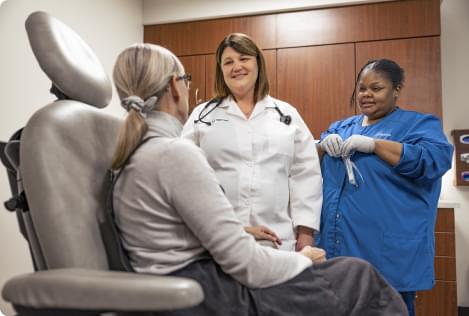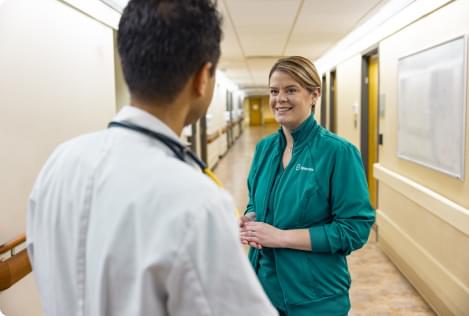Overview
Geographic atrophy is a serious eye condition. It occurs in people with another eye condition called age-related macular degeneration. It is most common in people over age 60.
Over time, geographic atrophy can lead to loss of central vision, which helps you see what is in front of you. This happens when the light-sensing tissue at the back of the eye, called the retina, is damaged. The damaged retina can get larger over time, causing increasing vision loss.
Geographic atrophy can affect one or both eyes. There is no cure, but the FDA has approved some new therapies to slow down its progression. Other new treatments are being studied in clinical trials.
Symptoms
People with geographic atrophy may notice changes in vision that start slowly and get worse over time. Geographic atrophy often starts just outside the center of the retina and slowly moves inward. As it grows, you can lose central vision or have blurred or blind spots.
Many people keep decent central vision early on, but as geographic atrophy spreads, this vision can be lost. Vision loss can become severe over time. It can make it hard to drive, read, watch TV and do household chores. People with geographic atrophy usually keep their side vision, known as peripheral vision.
Common symptoms include:
- Fuzzy or blurry areas in your central vision.
- Trouble reading even with glasses.
- Needing brighter light to see details.
- Colors seeming less vivid.
Rare or less common symptoms include:
- Sudden onset of central blind spots.
- Distortion of shapes, such as straight lines seeming bent.
- Rapid drops in vision.
When to see a doctor
Geographic atrophy can develop quickly. See your eye doctor right away if you notice any of these changes:
- A sudden increase in blurry or distorted vision.
- New dark spots or blank areas in your vision.
- Flashes of light or floaters that seem to appear suddenly.
Causes
Geographic atrophy is an eye condition that can occur in people with another eye condition called dry age-related macular degeneration. It causes gradual loss of vision in people, usually as they age. It affects parts of the retina, the light-sensitive layer at the back of the eye.
The cause of geographic atrophy is not fully known. One main cause is damage to a layer of cells that support the retina. This is called the retinal pigment epithelium. The damage can happen because of natural aging or due to outside factors such as smoking.
Over time, this damage causes yellow deposits called drusen to form. These deposits are a sign of early retina damage. Drusen are made up of fats and pieces of cells. Drusen can make the immune system react, causing swelling. This leads to the death of important cells in the retina called photoreceptors. Photoreceptors help you see.
As these cells die, parts of the retina start to break down. This loss of cells and damage to the retina causes central vision to get blurry. It can lead to vision loss over time.
Currently, there is no cure for geographic atrophy. But scientists are researching ways to slow down the damage and help protect the retina from further harm.
Risk factors
Some people have a higher chance of developing geographic atrophy. Risk factors include:
- Age: People over age 60 are more likely to have geographic atrophy.
- Genetics: Certain gene changes make some people more prone to the condition.
- Family history: If a blood relative, such as a parent or sibling, has the eye condition macular degeneration, the risk of geographic atrophy is higher.
- Smoking: Current or past smoking can increase the risk.
- Other factors: Having high blood pressure or being overweight may play a role.
Complications
Other eye conditions can develop with geographic atrophy, including:
- Further vision loss: As more areas of the retina are damaged, blind spots can grow in size.
- A more advanced form of macular degeneration: Some people with geographic atrophy develop leaking blood vessels under the retina, which can rapidly damage vision.
- Blindness: In later stages of geographic atrophy, vision may drop below the level needed for activities such as driving, reading or watching TV.
- Stress and depression: Loss of vision can lead to high stress levels and depression.
To help manage the condition, understand your risk factors and schedule regular eye exams. Ask your eye doctor how you can help preserve your independence and quality of life. If you notice sudden vision changes, especially blind spots or distorted lines, call your eye doctor right away. Work with your eye care professional team to find the best treatment for you.
Prevention
There is no sure way to prevent geographic atrophy. However, these steps may help:
- Stop smoking: This is the most important step for lowering risk.
- Choose a healthy diet and lifestyle: Eating leafy greens, fruits, vegetables, fish and other antioxidant-rich foods may help.
- Have regular check-ups: Early detection could prevent more-serious vision conditions.
Diagnosis
Eye doctors often use several tests to find geographic atrophy and check how it changes over time.
- Visual acuity and reading tests: These tests check how well you see letters and words.
- Dilated fundus exam: The eye doctor puts drops in the eyes that make the pupils bigger and then shines a bright light into the eyes. The exam helps find changes that could affect your vision. You get your test results right after the exam.
- Optical coherence tomography, also called OCT: This painless scan of the retina shows details of each layer. It helps find thinning or damage. Results are usually available on the same day.
- Fundus autofluorescence, also called FAF: A special camera takes pictures of the back of the eye to look for damaged cells. These images are available right away.
- Amsler grid: This chart shows black lines forming small squares with a black dot in the center. When you have geographic atrophy, you may start to see blurry spots near the center of the grid. You can use it at home to help find changes in your vision.
Treatment
Until 2023, there were no approved treatments for geographic atrophy. Now, the U.S. Food and Drug Administration, also called the FDA, has approved two medicines for treatment. These are called avacincaptad pegol (Izervay) and pegcetacoplan (Syfovre). The medicines block proteins that might damage the retina. However, there is no lasting cure for geographic atrophy.
These treatments are given as shots in the eye. The shots generally are given every 1 to 2 months. Talk with your eye doctor to see if these medicines may be an option for you.
Side effects of the treatment can include:
- Redness or pain at the injection site.
- Small dark blobs called floaters in the vision.
- Risk of infection inside the eye, called endophthalmitis.
- Risk of new blood vessel growth inside the eye, called wet macular degeneration.
- Risk of inflammation inside the eye, called intraocular inflammation, vasculitis inflammation or vasculitis.
Gene therapy is being studied as a treatment for geographic atrophy.
Your eye doctor likely will ask you to have regular follow-up exams. This is to track any changes in your vision.
Your eye doctor also may ask you to use an Amsler grid. This test helps you check for changes in your vision at home. Using an Amsler grid each week can help you notice changes such as new blank spots or lines that look wavy.
Lifestyle and home remedies
Vision loss from geographic atrophy can affect everyday life. These tips may help:
- Use brighter lights for reading and detailed work.
- Try magnifying tools or electronic readers with larger text.
- Ask your eye doctor whether high-powered reading glasses or telemicroscopic glasses might help.
- Label items in large or bold letters.
- Stay active with exercise and hobbies you enjoy.
- Stay social by joining support groups, in person or online.
- Prepare your home with good lighting, clear walkways and color-contrasting steps. Remove items such as rugs that might increase your risk of falling.
- Ask your eye doctor for referrals to low-vision services.
Talk with your eye doctor about other ways to stay independent.
Preparing for an appointment
You likely will need an eye exam and testing to check for geographic atrophy. Make an appointment with a doctor who specializes in eye care — an optometrist or an ophthalmologist.
What you can do
Before your appointment:
- When you make the appointment, ask if you need to do anything to prepare.
- List any symptoms you're experiencing, including those that may not seem related to your vision changes.
- List all medicines, vitamins and supplements you take, including the doses.
- Ask a family member or friend to go with you. You may need someone to drive or be with you after your appointment.
- List questions to ask your eye doctor.
For geographic atrophy, questions to ask include:
- How advanced is my condition?
- Will I experience more vision loss? If so, how quickly will that happen?
- Can my condition be treated?
- How should I monitor my vision for changes?
- What changes in my symptoms should I call you about?
- What low vision aids might help me?
- Are there any lifestyle changes I can make to protect my vision?
What to expect from your doctor
Your eye doctor is likely to ask you a few questions, such as:
- When did you first notice your vision condition?
- Does the condition affect one or both eyes?
- Do you have trouble seeing things near to you, at a distance or both?
- Do you smoke or did you used to smoke? If so, how much?
- What types of foods do you eat?
- Do you have other medical conditions, such as high cholesterol, high blood pressure or diabetes?
- Do you have a family history of macular degeneration?
© 1998-2025 Mayo Foundation for Medical Education and Research (MFMER). All rights reserved. Terms of Use


